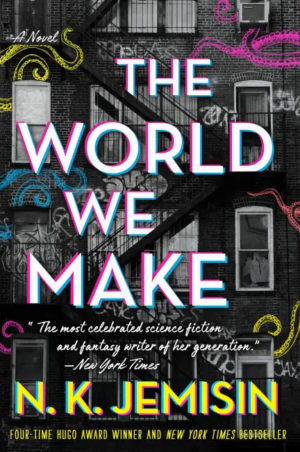The World We Make
by N. K. Jemisin
reviewed by Daniel A. Rabuzzi
N. K. Jemisin’s The World We Make concludes the story begun in 2020’s The City We Became with verve, compassion, and Swiftian wit. (The two books should be read as one; I recommend reviews of the first book by Elizabeth Hand, Tochi Onyebuchi, and Amal El-Mohtar.) Jemisin—the only author to ever win three Hugo Awards for Best Novel in consecutive years—is arguably the greatest living writer of science fiction and fantasy (SFF). In The Great Cities Duology, Jemisin uses classic SFF tropes to deconstruct systemic racism, authoritarianism, and anti-urbanism, while sketching the contours of an equitable, collective future. She pulls no punches, yet she neither sermonizes nor proposes easy solutions. After all, the adversary confronting the heroes of The World We Make is genocide itself. Instead, Jemisin plays on the surreal and the grotesque to help us understand a reality gone awry, remember our shared humanity, and defeat racism and xenophobia. The World We Make provokes laughter through angry tears, reinforcing the desire to fight on; it is that rarest of things: a political novel that succeeds as a work of art.
In The World We Make, a city’s soul is represented by an individual resident who becomes its avatar. New York City has an avatar, as does each of its five boroughs (and Jersey City, an honorary sixth borough). The avatars embody New York in all its multicultural glory, representing a wide spectrum of gender, race, religion, ethnic and linguistic origin, sexual orientation, political engagement, domicile, education, and class positions—a rebuke to the many stories about NYC that erase people of color. Insisting on a monochromatic story, however, is The Woman In White, the avatar of R’lyeh, an extra-dimensional city invading our world. R’lyeh is one of H. P. Lovecraft’s most famous creations, a lost city housing a demon seeking to obliterate humankind. Phantasmagoric battles are waged between the avatars and regular New Yorkers on one side and The Woman In White and her legions of monsters on the other.
The battles in The World We Make combine the eldritch with the gonzo. Jemisin epitomizes New York moxie: a Biggie song rallies the neighborhood against suburban white racists who have invaded Black Brooklyn’s main thoroughfare; the avatar of The Bronx recites “The Raven” to outflank The Woman in White; a spectral Brooklyn chop shop waylays another racist attack. One of the funniest sentences introduces the final confrontation: “the manhole covers blow off and the subway grates pop up, and R’lyeh’s foot-monsters are suddenly met by an equally vast flood of—oh, God, rats and pigeons and cockroaches, and pigeons carrying rats holding cockroaches!”
Jemisin is equally adept at creating multifaceted characters—a remarkable feat given that The Great Cities Duology is an allegory. With her exquisite ear for the joyous, unapologetically vulgar language spoken on the streets and in the kitchen, Jemisin rivals Colson Whitehead, Chang-rae Lee, and Gary Shteyngart. Particularly moving are quiet sidewalk and subway scenes set in the aftermath of an attack, when a cross section of strangers come to the aid of the afflicted, often deploying humor as a shared defense. (Take this exchange between two of the borough avatars: “You stopped at the farmer’s market in the middle of an extradimensional crisis?” “Dude, we’re always in some kind of crisis. Meanwhile, these were on sale!”)
Jemisin also helps readers understand the fears and motivations of New York’s opponents, specifically the avatar of Staten Island, whose betrayal of the city is a central theme. Several of the most poignant scenes in the book revolve around the Staten Island avatar’s tortured realization that her decisions are harmful in a chapter entitled “The Pizza of Existential Despair” and her growing awareness that many of her neighbors exclude iconic Staten Island creative forces like the Wu-Tang Clan. Jemisin even takes pity on The Woman In White, who is herself merely the tool of big bosses at the sterile, Brutalist core of the multiverse, and who may desire the very creativity she works to destroy.
The World We Make at times feels rushed. Jemisin’s febrile inventions outrun the plot (which may not be a shortcoming after all, as it reminds me of the tumult at major intersections in the city). It also feels uncomprehensive, since even Jemisin’s uncanny prescience can hardly keep pace with recent events. (Jemisin has noted that the New York of the first book no longer exists post-COVID, and that she chose to curtail the originally planned trilogy.)
Yet in her ability to convey the sheer physicality of the city and its speech, Jemisin does for New York what Dickens did for London, Balzac for Paris, and Döblin for Berlin. A reader of The World We Make tastes “cheesecake dense as concrete, burnt too-salty pretzels, a Coke and a slice,” blinks in “the light of old subway stations, and the Coney Island rides at night, and poorly maintained streetlamps,” listens at “corner barbecues selling plates.” In reinventing traditional artistic forms, Jemisin does for SFF what Claudia Rankine does for the prose poem, Terrance Hayes for the sonnet, Renee Gladman for asemic writing. As Jemisin says: “City magic is liminal. It likes the hidden stories, the perceptual-conceptual shifts, the space between metaphor and reality.” Fortunately for this great city, it has found in Jemisin a worthy bard.
Published on March 14, 2023

